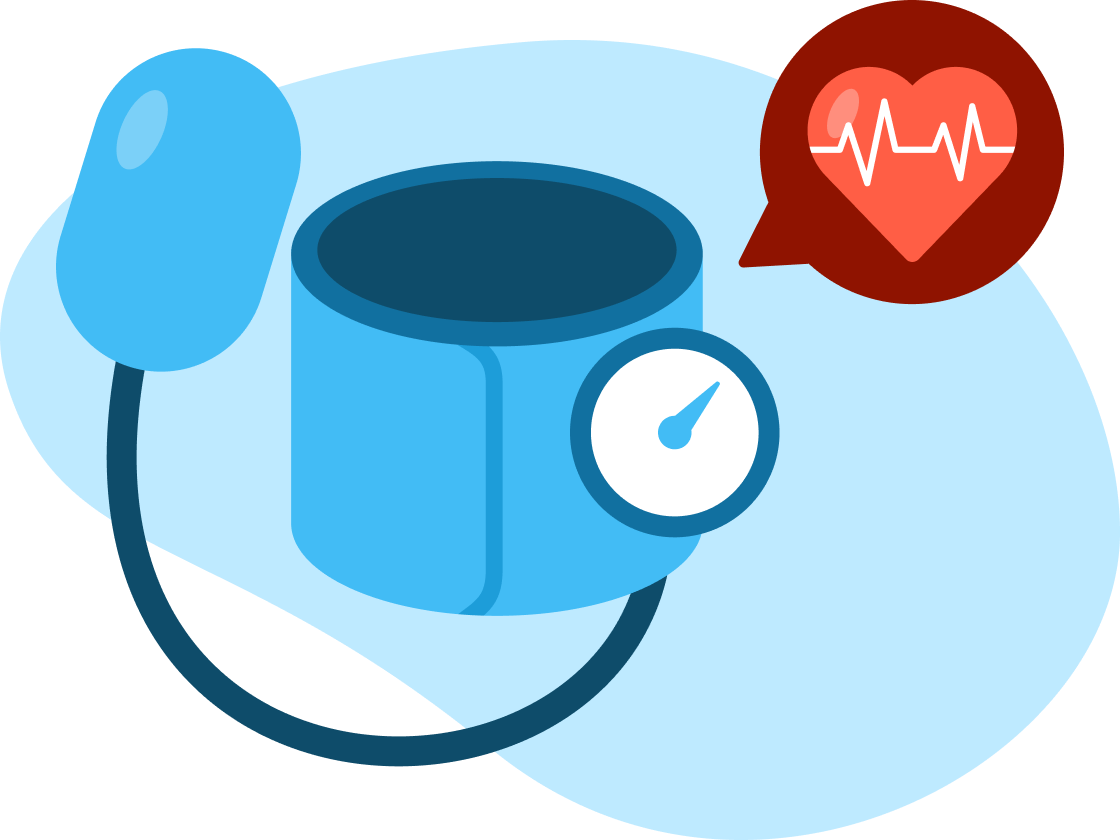By: Tracey Mohr, PsyD, A-CBT, NBC-HWC | Reviewed by Laura Hagopian, MD, FAWM, FACEP
Published on: May 14, 2025
Read Time: 3 Minutes

Though millions of Americans have high blood pressure, or hypertension, many aren’t quite ready to take action. In fact, studies have found between 10% and 40% of people are in a stage called “contemplation” (1,2,3) — where they think about change, but aren’t actively taking steps.
There are lots of reasons people aren’t quite ready to change. For some, the commitment and time feel like a tough pill to swallow. Others are overwhelmed if they’ve tried to change in the past without success. Also, some folks aren’t sure how or why a change can help. Managing blood pressure can be complex and confusing. From taking meds, to exercise and diet, it can be hard to know where to begin.
So what if you’re stuck thinking about change — and aren’t quite ready to act? Here are two thought exercises you can use to figure out if making a change is the right choice for you.
Exercise 1: Make a “Benefits List”
To do this, grab a notepad and pen. Look up various reasons to change, or talk to others. Then compile all the benefits in one place. These can be “hard facts,” your own ideas, or stories from others. Here’s an example:
Benefits List
|
- My cousin Jamie takes meds for BP, and he says he feels better.
- I read that taking BP meds lowers the chance of a heart attack by 25% (6).
- My PCP says keeping my BP controlled can keep my brain sharp as I age.
- The DASH diet my doctor recommended could be good for other reasons, like preventing diabetes, which runs in my family.
|
Exercise 2: Weigh the pros/cons.
It may seem simple, but weighing the downside of changing against the possible benefits can be a really helpful exercise. If you can get to a place where the pros outweigh the drawbacks by about two-to-one, you’re more likely to make a change (5). Here’s an example:
Define the change you’re considering: Trying the DASH diet that my PCP recommends to manage hypertension (7).
What’s good about my life now (if I don’t change)?
- Don’t have to spend time thinking about my health.
- No commitment to trying new recipes I might not like.
- Enjoy eating hamburgers.
|
What could be the downsides if I don’t change?
- Hypertension can lead to risk of heart attack in my 50s, according to my PCP.
- My kids will keep nagging me to take better care of my health.
|
What’s hard about change?
- Not sure I want to spend money on fresh veggies and fruits.
- Have to give up hamburgers and high salt food, or only eat them occasionally.
- Takes time to plan and prepare my meals.
|
What are the upsides of change?
- I’ll lower my risk of heart attack or stroke.
- Healthy BP can protect against dementia, which runs in my family.
- DASH diet could help prevent diabetes, too.
- I might actually enjoy some new meals!
- I don’t have to totally give up ice cream and hamburgers — I’ll enjoy them even more when I have them occasionally.
- I could make meal prep more interesting by playing my fav tunes, letting me chill after a long day.
|
Tips on exercise 2: When you make a pros and cons chart, note that the blue box is about acknowledging what’s okay about the status quo. The yellow box represents your possible blockers. What you list in the red box are the risks of not changing. And finally, the green box represents the reasons — personal, health, family, or otherwise — that a change would be worthwhile. For a challenge, can you get the number of items in the green box to be twice as many as the yellow box?
A final note
Last but not least, consider talking about your reasons to change with someone you trust. Maybe that’s a coach, friend, or healthcare provider. The right support can make a huge difference.
References:
1) Prochaska, J. O., & Velicer, W. F. (1997). The transtheoretical model of health behavior change. American Journal of Health Promotion, 12(1), 38-48. https://journals.sagepub.com/doi/10.4278/0890-1171-12.1.38
2) Nigg, C., Hellsten, L., Norman, G., et al. (2005). Physical activity staging distribution: Establishing a heuristic using multiple studies. Annals of Behavioral Medicine, 29(Suppl), 35-45. https://doi.org/10.1207/s15324796abm2902s_7
3) Manchaiah, V., Rönnberg, J., Andersson, G., et al. (2015). Stages of change profiles among adults experiencing hearing difficulties who have not taken any action: A cross-sectional study. PLoS One, 10(6), e0129107.
4) Whelton, P. K., Carey, R. M., Aronow, W. S., et al. (2018). 2017 ACC/AHA/AAPA/ABC/ACPM/AGS/APhA/ASH/ASPC/NMA/PCNA guideline for the prevention, detection, evaluation, and management of high blood pressure in adults: A report of the American College of Cardiology/American Heart Association Task Force on Clinical Practice Guidelines. Circulation, 138(17), e484–e594.
5) Prochaska, J. O., & Prochaska, J. M. (2018). Changing to thrive: Using the stages of change to overcome the top threats to your health and happiness. Hazelden Publishing.
6) Wright, J. T., Williamson, J. D., Whelton, P. K., et al. (2015). A randomized trial of intensive versus standard blood-pressure control. The New England Journal of Medicine, 373(22), 2103-2116.
7) Van Horn, L., Carson, J. A., Appel, L. J., et al. (2016). Recommended dietary pattern to achieve adherence to the American Heart Association/American College of Cardiology (AHA/ACC) guidelines: A scientific statement from the American Heart Association. Circulation, 134(22), e505-e529.
